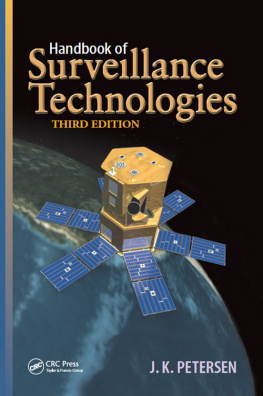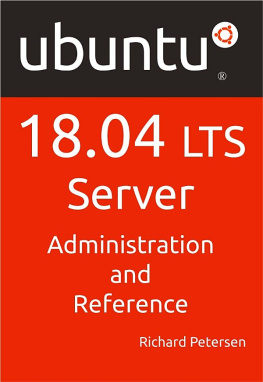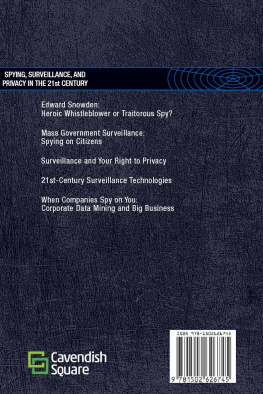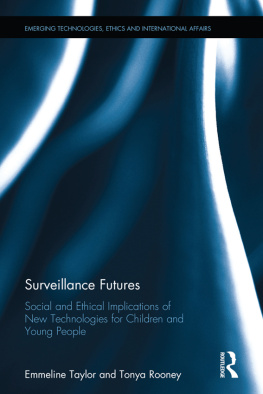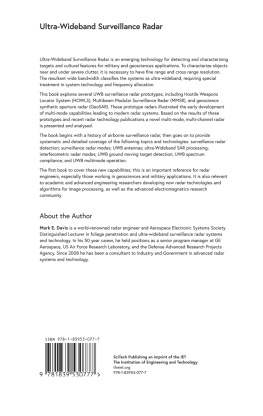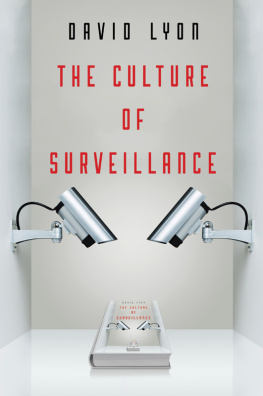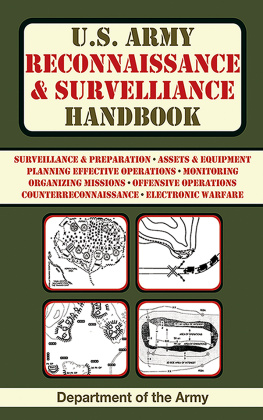Handbook of
Surveillance
Technologies
THIRD EDITION
J. K. PETERSEN
CRC Press
Taylor & Francis Group
6000 Broken Sound Parkway NW, Suite 300
Boca Raton, FL 33487-2742
2012 by Taylor & Francis Group, LLC
CRC Press is an imprint of Taylor & Francis Group, an Informa business
No claim to original U.S. Government works
Version Date: 20120217
International Standard Book Number-13: 978-1-4665-5413-9 (eBook - ePub)
This book contains information obtained from authentic and highly regarded sources. Reasonable efforts have been made to publish reliable data and information, but the author and publisher cannot assume responsibility for the validity of all materials or the consequences of their use. The authors and publishers have attempted to trace the copyright holders of all material reproduced in this publication and apologize to copyright holders if permission to publish in this form has not been obtained. If any copyright material has not been acknowledged please write and let us know so we may rectify in any future reprint.
Except as permitted under U.S. Copyright Law, no part of this book may be reprinted, reproduced, transmitted, or utilized in any form by any electronic, mechanical, or other means, now known or hereafter invented, including photocopying, microfilming, and recording, or in any information storage or retrieval system, without written permission from the publishers.
For permission to photocopy or use material electronically from this work, please access www.copyright.com (http://www.copyright.com/) or contact the Copyright Clearance Center, Inc. (CCC), 222 Rosewood Drive, Danvers, MA 01923, 978-750-8400. CCC is a not-for-profit organization that provides licenses and registration for a variety of users. For organizations that have been granted a photocopy license by the CCC, a separate system of payment has been arranged.
Trademark Notice: Product or corporate names may be trademarks or registered trademarks, and are used only for identification and explanation without intent to infringe.
Visit the Taylor & Francis Web site at
http://www.taylorandfrancis.com
and the CRC Press Web site at
http://www.crcpress.com
D EDICATION
This book is dedicated to those endeavoring to strike a balance between right of access and respect for privacy, for that which we take from others, may eventually be taken from us.
A BOUT THIS BOOK
T his has been almost a 20-year endeavor of research and writing and, since technology is changing faster than it can be documented, its a scramble to keep up. By the time a new device or new format hits the shelves, its obsolete, and its difficult to describe its importance in the overall scheme of surveillance development because we dont know what will supersede it tomorrow.
One of the biggest problems the author encountered in developing this book, was discovering many fallacies and errors in supposedly reputable texts documenting technology history. Keep in mind that the first edition was published long before aggregate sources (e.g., Wikipedia) were available or well-known to Web users, so books were still a primary source of information exchange. While no text can be perfect, no matter how well researched, a surprising amount of erroneous information was found in the search for historical and contemporary data on surveillance technologies. For this reason, the author consulted original sources, as much as possible, and poured over tens of thousands of government documents, patents, manufacturing specifications, oral histories, archived photos, engineering white papers, and informal diagrams of early inventions. In almost every case, the person traditionally credited with an invention wasnt the first to invent it. Significant examples include the telephone (Meucci was far ahead of Bell), telegraph, magnetron, radar, and even the breakthrough electronic transistor.
Another difficulty in producing a comprehensive text is the volatile political climate. The destruction of the World Trade Center and the subsequent creation of the Department of Homeland Security wrought significant changes in focus and funding and on the structure of the U.S. Intelligence Community. Allegations of unwarranted wiretapping by the government and illegal use of surveillance devices by regular citizens have both been much in the news. Some of the concerns are justifiedcriminals have unprecedented tools for committing crimes, but the potential for invasion of privacy and loss of constitutional freedoms stemming from the proliferation of surveillance technologies is enormous, as well, and must be considered a priority.
P REFACE
T his book sets the groundwork for understanding surveillance technologies by describing contemporary devices and current legislation in their historical context. The stepping stones that led to where we are today make it easier to understand the basic ingredients of todays more sophisticated devices, and will help create a mental map for understanding more specialized texts on radar, sonar, video cameras, satellite imaging, and genetic profiling.
This book is suitable as a general reference and also as a foundation text for post-secondary institutions offering surveillance studies courses.
Understanding Surveillance Technologies was published as the first comprehensive, introductory overview of the field of surveillance devices. The current Handbook of Surveillance Technologies comprises 18 chapters with more than 700 photos and illustrations. It is suitable for college surveillance studies in sociology and political science, professional recruiting programs, and as a reference for beginning professionals in the fields of law enforcement, forensics, and military surveillance. It is also an indispensable reference for journalists, lawmakers, and community planners. It has been designed with a flexible, modular format so the chapters can be read in almost any order and chapters that share common topics are cross-referenced to alert the reader.
We are all being surveilled. It is no longer possible to avoid cameras; DNA tests; identity chips; border crossing cameras; highway monitors; ATMs; radio-chipped goods and ID cards; and other devices that record our movements, finances, and even our health. Even now, many people are unaware of the extent to which their activities are stored in a multitude of databases, many of which are accessible on the Internet without the surveillees knowledge or consent. Here are examples that illustrate this unsettling trend:
Detailed information about people who have never logged onto the Net nor even used a computer is available to anyone with an Internet connection. By aggregating public information (which changes the character of that information) one can quickly search ages, occupations, former employers and former residences and, further, it is possible to acquire the names, addresses, phone numbers, ages, financial status, and occupations of a persons relatives and neighbors, as well. This turns personal information into a commodity and provides those seeking to exploit it, the data to create a composite picture of a neighborhoods social and economic characteristics. Similarly, social networking sites have been caught sharing personal information or opening it up to third-party commercial interests without notifying their users. This book provides a better understanding of who is collecting this information, how they are doing it, and how it is being used.

